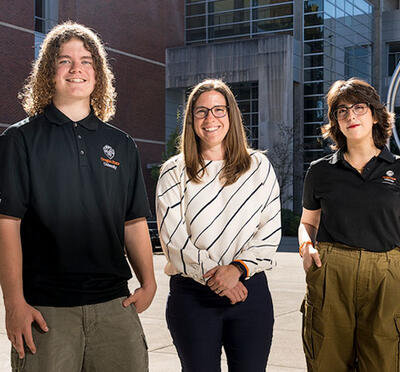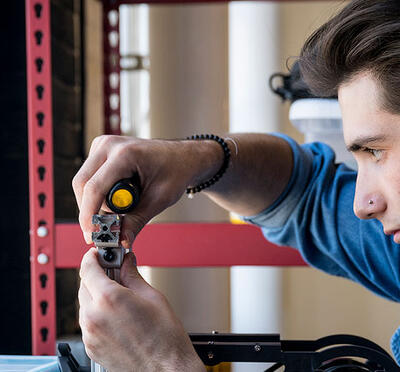A Team Of Researchers With International Roots Is Collaborating To Tackle A Global Crisis
To say Bahman Abbasi is driven would be an understatement.
Just a year after joining Oregon State University, the assistant professor of mechanical engineering landed a $2 million grant from the Department of Energy to develop novel technology to turn saltwater into drinking water. At the time, it was the largest award in the history of OSU-Cascades, where his lab is located.
The next year, he received another $3 million from DOE to tackle the problem of treating hydraulic fracturing wastewater.
“Very broadly speaking, we have two main goals. The first, very modest goal is to save the world,” Abbasi said.
Globally, more than 785 million people lack access to basic drinking water, according to the World Health Organization. Climate change and population growth are intensifying water scarcity around the world. A study by the World Resources Institute found that the most water-stressed countries are
in the Middle East and North Africa. But India’s reservoirs are drying up, and there are even pockets of extremely high water stress in the U.S., in places like New Mexico. Other developed Western countries, such as Belgium and Italy, are only slightly better off, designated as experiencing high water stress.

“The second goal is to provide the best education possible for postdocs and students at all levels,” he said. “A large part of their education happens in the lab when they face a real-world problem.”
A Collaborative Effort
Abbasi found students who were collaborative, willing to learn, and motivated to help save lives around the globe. He and research associate Xiang (Shawn) Zhang then worked to create an environment and culture that inspires teamwork. In the large, open space of the Water and Energy Technologies Laboratory, small teams work together on the different components of the larger project.
Abbasi’s students and postdocs come from all over the world: China, India, Iran, Sudan, Nigeria, and the United States.
“I didn’t really look for diversity of ethnicity, gender, and creed,” he said. “It just organically materialized when I looked for the best people.”
In the center of the lab is a whiteboard where team members write inspirational sayings from any culture, not just their own. It is a representation of the respect they have for each other’s differences, which is central to the collaborative spirit that they apply to their work.
“We are all looking at the problem from different angles,” said Elnaz Nikooei, graduate student of mechanical engineering.
The team extends beyond Oregon State. Essential to the effort are experts at the University of Maryland, Michigan State University, and the University of Nevada, Reno, who are contributing knowledge
in areas such as additive manufacturing, chemistry, and heat exchangers.
Technology Breakthroughs
“In research, if everything goes as expected, it means you’re not pushing the envelope. We always encounter new things that we hadn’t foreseen,” Abbasi said. “But the good news is that we’ve overcome most of it.”
Abbasi’s vision for the desalination project was to develop a new technology that uses less energy than traditional, evaporative desalination, which requires powerful blowers and high-pressure pumps. Instead, his system humidifies and dehumidifies air so the salt can be extracted using less energy.
A critical component of the system is the thermal fan that can run on low-grade energy, such as solar power, and produce high-pressure air to vaporize the saltwater. That key piece, one of the first problems the team took on, has now been built and tested, and it is performing as Abbasi hoped. In addition to applying for a patent, he has spun it into another independent project.
The second component is a novel atomizer that addresses a problem of traditional systems, in which contaminated water can clog orifices.
“We changed that by designing a new atomizer that fills the top of a perforated plate with contaminated or saline liquid and blasts it from underneath with high-speed air jets. This way, we do not have any liquid that passes through an orifice. Instead, the air jets atomize and spray a sheet of liquid, which floats on top of the plate,” he said.
His lab has demonstrated the device can atomize water with the spray properties they want, including droplet size and air-to-water ratio. Another component is a cyclonic separator to produce potable water by removing salt from a humid air stream. The final component is a heat exchanger to recoup some of the energy that goes into the system.
“That will be critical for cost competitiveness and environmental sustainability,” Abbasi said.
Abbasi expects he can borrow the atomization and spray evaporation ideas from the desalination project and apply them to the system for cleaning fracking wastewater. The team has also developed a nozzle to suck in waste vapor and has demonstrated the ability to separate clean water from gaseous contaminants, such as benzene and toluene.
To recover water from the system, they have created an inline de-mister that uses a swirling motion to push mist to the walls of a cylinder, where it can be extracted.
“In over 100 different experiments with various parameters, we’ve shown that we can extract a little over 97% of the condensed water from the system with minimal contamination,” Abbasi said.
Abbasi has applied for patents for each of the two systems. There is also potential to combine the systems by simply chaining them — first desalinating, then removing contaminants — but Abbasi has bigger idea.
“We are thinking of something more integrated and sophisticated that merges the two technologies for a more efficient system. But it is not a trivial problem,” he said.
Of course, it would not be interesting to Abbasi if it were trivial.



